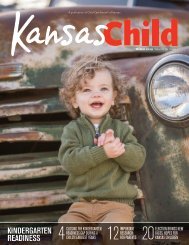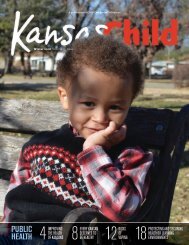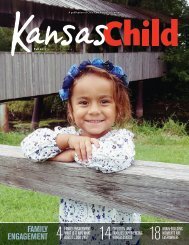Kansas Child Winter 2016
Kansas Child magazine is intended to provide a forum for the discussion of child care and early education issues and ideas. We hope to provoke thoughtful discussions within the field and to help those outside the field gain a better understanding of priorities and concerns. The views expressed by the authors are not necessarily those of Child Care Aware® of Kansas or their sponsors.
Kansas Child magazine is intended to provide a forum for the discussion of child care and early education issues and ideas. We hope to provoke thoughtful discussions within the field and to help those outside the field gain a better understanding of priorities and concerns. The views expressed by the authors are not necessarily those of Child Care Aware® of Kansas or their sponsors.
You also want an ePaper? Increase the reach of your titles
YUMPU automatically turns print PDFs into web optimized ePapers that Google loves.
Community discussions<br />
into child care issues in<br />
LORI STEELMAN<br />
<strong>Child</strong> Care Licensing<br />
Program, <strong>Kansas</strong><br />
Department of Health<br />
and Environment<br />
Lori Steelman directs the Early Care & Youth<br />
Programs within the <strong>Child</strong> Care Licensing<br />
Program, <strong>Kansas</strong> Department of Health and<br />
Environment. She has worked with child care<br />
licensing for the state since 2010 and became<br />
the director for the program in 2012.<br />
Previous related experience includes<br />
operating a home day care and contracting<br />
with Early Head Start and working with<br />
families that are deemed at risk through<br />
a non-profit under a <strong>Kansas</strong> CASA. She<br />
has Bachelor of Arts in Psychology from<br />
Southwestern College, Winfield, KS and a CDA.<br />
By Lori Steelman, <strong>Kansas</strong> Department<br />
of Health and Environment<br />
Answering the question “what is the<br />
need for child care in <strong>Kansas</strong>” is difficult<br />
and is dependent on a number of factors.<br />
Feedback received during 14 Town Hall<br />
meetings the KDHE <strong>Child</strong> Care Licensing<br />
Program held in early 2015 provided<br />
insight to some of the challenges parents<br />
face when searching for child care that<br />
best meets the needs of their family. At<br />
each of these meetings, parents, providers<br />
and community members were asked<br />
what challenges related to child care<br />
were common in their community.<br />
Responses were similar across the state<br />
and included: the shortage of infant/<br />
toddler care, high staff turnover, and the<br />
availability of face-to-face professional<br />
development opportunities.<br />
Currently there are approximately<br />
5,800 <strong>Kansas</strong> licensed child care facilities,<br />
including: licensed day care homes,<br />
group day care homes, child care centers,<br />
preschools, school-age programs, and<br />
drop-in programs for school-age children<br />
and youth. The combined total licensed<br />
capacity is just over 137,000. Based on<br />
the number of calls received at KDHE,<br />
there continues to be a great need for<br />
infant and toddler care. Parents searching<br />
for child care are directed to the referral<br />
services offered by <strong>Child</strong> Care Aware® of<br />
<strong>Kansas</strong>. Even with the expert assistance<br />
of a referral counselor, finding infant<br />
care—especially home-based care—can<br />
be challenging. The license capacity for<br />
a day care home or group day care home<br />
is determined by the age of the youngest<br />
child in care and reduces the total number<br />
of children that may be cared for at any<br />
given time. Given the financial impact,<br />
it’s not uncommon for a home provider<br />
to take only older children, those no<br />
longer considered an infant (18 months<br />
of age or older). Infant units in child<br />
care centers require a 1 to 3 staff/infant<br />
ratio and have a maximum group size of<br />
9 infants. Additionally many owners and<br />
program directors of child care centers<br />
are challenged with high staff turnover—<br />
directly impacting the ability to keep<br />
an infant and/or toddler room open<br />
and at capacity.<br />
The town hall discussions also revealed<br />
concerns regarding the general public<br />
perception of a child care provider. <strong>Child</strong><br />
care providers expressed the belief that<br />
they are not viewed as professionals worthy<br />
of wages that reflect the true cost of the<br />
services they provide. The inability to<br />
achieve a balance between the true cost<br />
of care and affordability for parents often<br />
leads to low wages or unfilled slots that<br />
are viewed as too costly. <strong>Child</strong> care is<br />
a business that places the responsibility<br />
of our most vulnerable population in<br />
the homes and facilities of licensed<br />
10 <strong>Kansas</strong> <strong>Child</strong> A Publication of <strong>Child</strong> Care Aware ® of <strong>Kansas</strong>
















